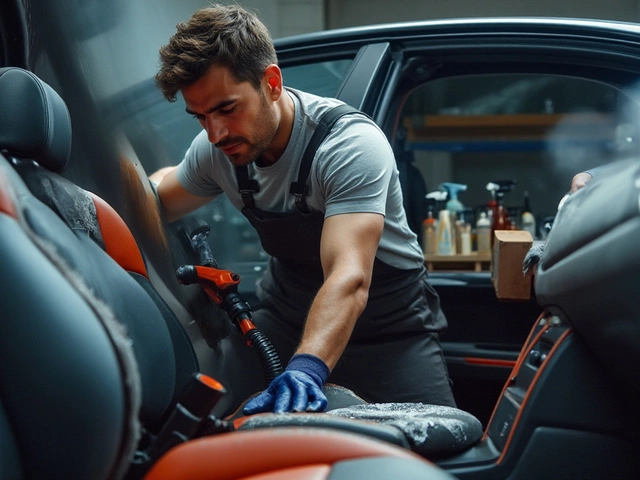Ever wondered why some cars look like they just rolled out of a showroom while others don't? The secret is all in the detailing order. If you’re new to car detailing, knowing the right sequence can save you time, effort, and give your ride that pro-level shine.
Start with the prep work. You'll want to gather all your tools and products before you begin. Think of it as assembling your car cleaning arsenal: buckets, sponges, microfiber cloths, a good pH-balanced soap, wax, polish, vacuum, and any other favorite products. Make sure you're working in a shaded area to avoid unpleasant streaks from the sun drying things too fast.
Once you're all set, tackle the exterior first. Always begin with rinsing the car to remove the loose dirt. This is crucial because it minimizes the risk of scratches generated by scrubbing those pesky particles into the paint. Pro tip: work from top to bottom. Gravity, folks! The dirt flows downwards. After a thorough wash and rinse, drying with a microfiber towel is key to preventing water spots. Remember, the devil is in the details, and a meticulous approach can make a world of difference.
Preparation Steps
So, you're about to start detailing your car. Great! But before you dive in, you need to make sure you've got everything ready. Jumping into car detailing without prep can be like cooking without the ingredients—you’re bound to miss something important.
Gather The Right Tools and Products
First up, ensure you have all the car detailing equipment you'll need. This includes:
- Two buckets – one for washing and one for rinsing (helps avoid transferring dirt back onto the car)
- Quality car wash soap – don't just use any soap lying around; a pH-balanced one works best
- Microfiber wash mitts – gentle on paint, these are a must to avoid scratches
- Microfiber towels – for drying and polishing
- Vacuum cleaner – a handheld one will make your interior cleaning easier
- Glass cleaner – nobody likes smudgy windows
- Wax or sealant – to give that finishing touch and protect the paint
Pick the Perfect Spot
Next, consider where to do the job. Ideally, you should work in a shady area or garage. Direct sunlight is your enemy here as it can dry water and soap too quickly, leaving spots or streaks on the surface.
Get the Timing Right
The time you spend depends on your car’s condition and your experience. It might be tempting to rush through, but give yourself space to work without pressure, especially if you're new to the detailing game.
Optional Extras
If you want to go above and beyond, having a clay bar kit for more intensive cleaning and a tire gel for that extra shine can elevate your results. Think about what meets your vehicle's needs the most.
Getting these preparation steps right positions you for success, transforming your car from everyday to spectacular. It's all in the small details and having a plan really pays off.
Exterior Detailing
When it comes to making your car shine, exterior detailing is where the magic happens. This process isn't just about looking good but also about protecting your car’s surface. Let’s break down the steps to ensure you get that show-stopping glow.
Washing It Right
Start with a thorough rinse to get rid of loose dirt. Use a pressure washer if you have one available, but a regular hose works too. Follow this with a two-bucket method—one for the clean soapy water and another for rinsing your sponge. This minimizes swirling scratches caused by grit. Opt for a pH-balanced soap because harsh detergents can strip away wax and degrade the paint.
Clay Bar Treatment
After washing, your car's surface might still be a tad bumpy. That’s where a clay bar comes in handy. It removes embedded contaminants—stuff you can’t get off otherwise. Move the clay gently over lubricated paint; it’s a small effort for a big payoff.
Polishing
Let’s talk polish. This step isn't mandatory every time, but it sure helps in eliminating minor scratches and swirl marks. Think of polishing as a slightly abrasive process that brings out the paint’s natural sheen. Use a dual-action polisher to make the job easier on your arms.
Sealing the Deal with Wax
Finally, sealing your hard work with wax retains the glossy finish and protects against sun damage and road grime. Whether you use paste, liquid, or spray wax, just make sure it's high-quality. Apply it in small, circular motions and buff it off with a soft microfiber cloth.
Fun fact: Did you know professional detailers often use a dedicated wax just for the tires? This ensures they stand out as much as the rest of the car. The whole process might sound a bit elaborate, but take it one step at a time, and you’ll wonder why you didn’t start sooner.

Interior Cleaning
Moving inside the car, where things can get a bit more personal, it’s essential to tackle this with as much care as the exterior. The goal is to create an inviting interior space that's as enjoyable to ride in as it is to look at it from the outside.
Start with Decluttering
Begin by removing all the clutter. Empty out door compartments, cup holders, and the glovebox. Mats should be taken out to shake off loose dirt. This clears the way for a thorough clean.
Vacuum the Entire Interior
This step is about getting rid of the crumbs, dirt, and any other bits hiding in the cracks and crevices. Use the various attachments on your vacuum to get under seats, between cushions, and into cup holders.
- Use a nozzle attachment for tight areas.
- Don't forget the trunk and under floor mats.
- Focus on seams because dirt loves to hide there.
Wipe Down and Clean Surfaces
Now it's time to wipe down, using suitable cleaners for different surfaces like leather, vinyl, and plastic. For the dashboard and other surfaces, a microfiber cloth with a light cleaner usually does the trick. Make sure to read the labels of any products to ensure they're safe for your car materials.
Car detailing doesn't stop at just looking clean; it's about maintaining materials, too. Consider applying a conditioner on leather seats to keep them supple and avoid cracks.
Windows and Mirrors
As a finishing touch, clean all interior glass surfaces with a glass cleaner. This step's often overlooked, but clear windows and mirrors add to that crisp, finished look.
FAQs about Interior Cleaning
| Question | Answer |
|---|---|
| How often should I clean the car's interior? | Every two weeks for regular use, but more frequently if you have kids or pets. |
| Can I use home cleaning products? | Be cautious; some household products can damage car interiors or leave a sticky residue. |
By following these steps, you'll not only have a clean car but a fresh-smelling and cozy environment that makes the drive much more enjoyable.
Finishing Touches
Now that you've covered the basics, it's time to focus on the final strokes that make a car detailing session feel professional. This is where attention to detail sets the novices apart from the experts.
Tire and Trim Care
Your tires and trims often get overlooked but are crucial for that completed look. Apply a dedicated tire dressing to give them a rich black finish. Make sure to use a product that won't sling onto your freshly cleaned car. For the trims, a little application of a plastic restorer will keep them looking fresh and resist fading.
Wax On, Wax Off
No doubt about it—the great shine comes from a thorough wax job. Applying wax not only gives the paint that glossy look but also adds a protective layer against the elements. Use a small applicator pad and apply a thin, even coat to the entire car exterior. Remember, it’s better to apply two thin layers than one thick layer.
Buff it off with a clean microfiber cloth, working in small sections. The result should be a dazzling shine that reflects your surroundings like a mirror.
Window Perfection
Don't forget the windows. Use a quality glass cleaner inside and out to eradicate smudges and streaks. A little tip: wipe vertical on the outside and horizontal on the inside. That way, if you spot more streaks, you know which side needs a touch-up.
Final Inspection
Once your car is glowing, don't just assume it's done. Walk around and inspect for missed spots. Check for water drips, especially around mirrors and moldings. A quick pass with a microfiber and boom—blemish free.
| Frequency | Benefit |
|---|---|
| Monthly | Basic cleaning and maintenance |
| Quarterly | Wax application and deeper clean |
| Semi-annually | Full interior and exterior detailing |
Finally, admire your work. With these finishing touches, your car should look and feel its absolute best, ready to hit the road or just catch some admiring glances in the driveway. There’s something satisfying about seeing a job well done, knowing you've taken your car cleaning to another level.






